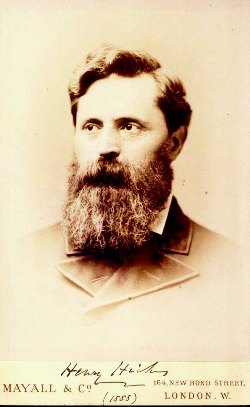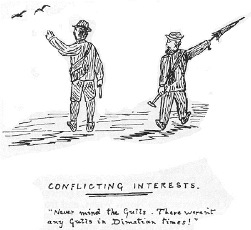Geologist and science writer Nina Morgan relishes a stratigraphic struggle.
 Gladiator fights must have seemed like Sunday school picnics compared to some of the debates over papers read at the Geological Society during the 19th Century. One paper that really raised hackles among the geological great and good was Archibald Geikie's 62-page study: 'On the supposed Precambrian rocks of St David's,' which was read in two parts on 21 March and 11 April 1883.
Gladiator fights must have seemed like Sunday school picnics compared to some of the debates over papers read at the Geological Society during the 19th Century. One paper that really raised hackles among the geological great and good was Archibald Geikie's 62-page study: 'On the supposed Precambrian rocks of St David's,' which was read in two parts on 21 March and 11 April 1883.
Hicks and stones
In the paper, Geikie [1835 – 1924], then Director General of the Geological Survey, refuted a suggestion put forward by Henry Hicks [1837 – 1899], that a base of the Cambrian System could be defined in a coastal section at St David's on the west coast of Wales. Hicks, a respected independent geologist who later served as 46th President of the Geological Society, argued that the Cambrian sediments at St David's lay unconformably above an exposed complex of sedimentary and meta-sedimentary Precambrian rocks. Hicks dubbed these complexes 'Pebidian' and 'Dimetian'. Geikie, on the other hand, argued that the Pebidian was part of the Cambrian series, and that the Dimetian was a post-Cambrian granite intrusion.
Although the debate centred on Welsh stratigraphy, the implications were more far-reaching, taking in everything from the age of the Earth to the reputation of the Geological Survey. With so much at stake, the gloves were off.
Marshalling forces
To defend his views, Geikie took to the field twice, each time taking along one of his star Survey mappers. On his first visit to Hicks's so-called Dimetian ridge, Geikie, accompanied by Benjamin Peach [1841 – 1926], was amazed to find not 'the slightest trace of any shale, schist, quartzite or other stratified rock'. Instead, the pair identified fairly ordinary granite. On his second trip, accompanied this time by William Topley [1841 – 1894], Geikie confirmed his belief that Hicks had got it all wrong.
After this opinion was expressed during the reading of the first part of Geikie's paper, Hicks determined to fight back. He returned to the key outcrops to gather further evidence to back his case, accompanied by members of the Cambridge undergraduate geological society, the Sedgwick Club. Club members, who described themselves as:
'...the expeditionary force summoned to St David's to defend the ancient Dimetian territory from the intrusive attacks of the Geikie Clan, a hostile tribe who had grossly outraged the great Hicks...'.
recorded their progress in the 'Book of St David's, which is now preserved in the present-day Sedgwick Club’s archives. As well as anecdotes and poems delighting in the prospect of defeating 'Geikie, Topley, Peach and Co.', the Book also includes field notes, some illustrated by cartoons. One, titled Conflicting Interests (below), suggests that not all of the Sedgwick Club 'warriors' kept their minds wholly on the geological task at hand.
 Winner?
Winner?
For the students, it all must have seemed like jolly lark. But for Geikie and Hicks, the debate was deadly serious. The winner? Both, it turns out, were right – to some extent. As Geikie argued, the Dimetian is now considered to be a post-Cambrian granite intrusion. But the existence of the Precambrian at St David's is now also universally accepted – and Hicks's Pebidian is thought to be part of it. Another ‘first’ for Welsh geology! Or, possibly, Cyntaf arall i ddaeareg Gymreig. Alas, such idioms rarely translate well.
Acknowledgements
This vignette was inspired by the paper Defining the base of the Cambrian: The Hicks-Geikie Confrontation of April 1883 by Paul N Pearson and Christopher J. Nicholas, Earth Sciences History, vol 11, no 2, pp 70-80. Further information was drawn from the references it contains. Thanks also to Paul Pearson for his help in summarising the issues involved in this complicated conflict, and for providing the cartoon illustration that accompanies this piece.
* Nina Morgan is a geologist and science writer based near Oxford. Her latest book, The Geology of Oxford Gravestones, is available via www.gravestonegeology.uk